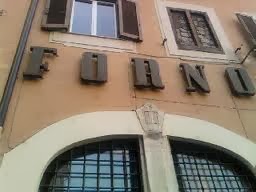Christmas is a magical time of year in Rome. The city bustles with festive twinkling lights, outdoor markets, holiday foodstuffs, concerts and more.
Rome Walks' Top Picks and Tips for a Roman Christmas
Shopping
 |
| Ornaments at the Piazza Navona Christmas Market |
Christmas Market at Piazza Navona
12 Dec - 6 Jan
The delight of children everywhere, starting mid-December Piazza Navona is filled with stands selling toys, candy, ornaments, figures for nativity scenes and much more. The square really comes to life in the late afternoon and evening with a carnival-like atmosphere: street performers, an old-fashioned carousel, and giant warm doughnuts slathered with Nutella.
Bagpipes
 |
| Zampognari |
Bagpipes in Italy?! A large format bagpipe known as a zampogna is a traditional instrument from shepherding communities in central and southern Italy. Players parade around the city marking the holidays with the forlorn notes of Italy's most famous (and perhaps only) Christmas carol: Tu scendi dalle stelle.
Food
 |
| Pandoro dusted with powdered sugar |
Many special foodstuffs only make their appearance during the holidays. Panettone and Pandoro are buttery yeasted cakes sold in big boxes. Torrone is a nougat made from nuts, eggwhites and honey, sold in brittle or soft variations. Addictively sweet clementines are in season -- grab half a kilo from a fruit-seller, they make a great on-the-go snack. And don't forget roasted chestnuts, sold in paper cones by vendors around the city. To experience some of the feasting that is such a hallmark of the season, reserve places at one of the many restaurants that offer special multi-course holiday dinners on the 24th, 25th and 31st of December.
Nativity Scenes
 |
| Classical Nativity Scene |
Few things are as dear to Italians as the presepe or presepio (nativity scene or creche), a vital folk art that brings the Christmas story to life through the diorama-like recreation of the birth of Jesus in a manger, surrounded by Mary, Joseph, the Magi, angels, animals, and sometimes hundreds of other figures engaged in their everyday village activities. Every church and main square boasts their own special presepio, and an annual exhibition of over a hundred can be seen in Piazza del Popolo.
Lights
 |
| Lights on Via del Corso, 2013 |
Every neighborhood in Rome is done up with fantastic light displays for the holidays, and any stroll around the center during the season will be brightened by the merry Christmas twinkle.
Music
 |
| A busy season for classical music |
If the bagpipers have whetted your appetite for seasonal music, you won't be disappointed: the city comes alive with many concerts of holy music. Almost all churches in the center host free concerts - check out posters outside churches for dates and times, most begin around 9:00 pm. Here are our suggestions for special concerts in Rome:
25 December
Beethoven, Haydn, Lizst, etc
Tempietto, Piazza Campitelli 9
26 December
Giovanni Allievi & Orchestra Sinfonica Italiana
Auditorium Parco della Musica, Viale del Coubertin 30
31 December
New Year's Concert - Opera Solos, Accademia dell'Opera Italiana
Chiesa Angelica All Saints, Via del Babuino 153
USEFUL INFO
Official Italian Holidays
25 December - Christmas
26 December - Feast of Saint Stephen
1 January - New Year's Day
6 January - Feast of the Epiphany
The Vatican Museums are closed on all of the dates above; the Colosseum, Forum and Palatine are closed on 25 December and 1 January.
Midnight Mass and Christmas Day mass at the Vatican in St. Peter's Square - write to nacvisoffrome@pnac.org for tickets





































